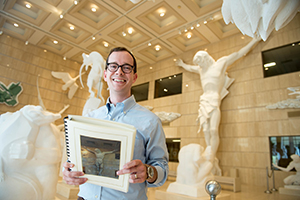July 11, 2016
Art scholar studies archives at SVSU’s Marshall M. Fredericks Sculpture Museum
 Nick Hartigan is an art scholar buried in paperwork, and he loves it.
Nick Hartigan is an art scholar buried in paperwork, and he loves it.
Hartigan, the first recipient of Saginaw Valley State University’s Fredericks-Follett-Roethke Graduate Fellowship in the Arts & Humanities, is spending much of July researching a pair of artists with works featured on SVSU’s campus.
His studies involve access to thousands of documents housed in the SVSU-based sculpture museum dedicated to one of those artists, the late Marshall M. Fredericks.
“The kind of comprehensiveness I’m finding in these archives is wonderful to me, as a researcher,” Hartigan says. “There’s a total scope available here that is rare to find in most museums.”
Hartigan is a fifth-year doctoral student at the University of Michigan, specializing in the study of 20th-century sculpture – particularly the period from 1965 to 1995. He is living on SVSU’s campus until the end of July, when he plans to return to Washington D.C. There, he recently finished participating in a pre-doctoral fellowship at the Smithsonian American Art Museum, and plans to finish his dissertation in the nation’s capital.
The events that led him to SVSU’s campus began more than a year ago when Marilyn Wheaton, director of the Marshall M. Fredericks Sculpture Museum, sought individuals interested in pursuing scholarly work on Fredericks, whose monumental sculptures appear in sites across the world.
Members of the History of Art program at the University of Michigan’s Horace H. Rackham School of Graduate Studies recommended Hartigan for the research. When Wheaton approached SVSU leaders about funding his visit, the seed was planted for what now is the Fredericks-Follett-Roethke Graduate Fellowship in the Arts & Humanities. The fellowship supports a new graduate student’s visit each year to SVSU’s campus, where that individual will study Fredericks, the late Saginaw-born poet Theodore Roethke or popular British author Ken Follett. SVSU also houses archived collections from Roethke and Follett.
“Hopefully this will add to SVSU’s excellent reputation for serious scholarly work,” Wheaton says of the fellowship.
Along with research, Hartigan’s visit will involve leading two presentations, free and open to the public.
While much of his research centers on Fredericks, Hartigan’s first talk will address another internationally-renowned artist with SVSU ties: the late land-art sculptor Nancy Holt, whose “Annual Ring” sculpture is located on the campus.
Hartigan’s presentation on Holt is scheduled Tuesday, July 12, at 6 p.m. at the Theodore Roethke Home Museum, 1805 Gratiot in Saginaw.
Hartigan says “Annual Ring” represents an anomaly of sorts for art of its kind. The site-specific sculpture is designed so that sunlight shining down on four circle-shaped openings in its dome-shaped cage casts an aligned sphere of sunlight on the ground every summer solstice at noon.
The U.S. General Services Administration commissioned Holt to create the sculpture specifically for its original location on the roof of the Federal Building in downtown Saginaw. Most artists or art owners often resisted the idea of moving site-specific sculptures elsewhere, Hartigan says. When the Federal Building was demolished in 1999, though, Holt supported “Annual Ring’s” relocation to SVSU.
“A lot of people thought, ‘You can’t just put a site-specific sculpture at a new site; it will become a different sculpture,’” Hartigan says. “What she did with this softened a lot of hard-liners.”
Hartigan’s second presentation will center on Fredericks. That talk is scheduled for 3:30 p.m. Tuesday, July 19 in SVSU’s Arbury Fine Arts Center, classroom A-107, adjacent to the sculpture museum.
Since Hartigan arrived at SVSU in late June, he has dug deep into the thousands of documents from Fredericks that are housed in the museum. The Fredericks Archives at the Marshall M. Fredericks Sculpture Museum were established in 2005 following receipt of the sculptor's business and personal records, and span the 70 years of Fredericks' career from 1928 to 1998, when he died.
Materials include personal, foreign ministry, and general correspondence as well as special letters and cards received by Fredericks; photographs relating to Frederick's teaching career, projects, civic activities, and personal life; project files, media articles, journals, clippings and books about Fredericks and his work.
The museum, of course, also features Fredericks’ sculptures and the plaster originals for many of his most recognizable sculptures, including “The Spirit Of Detroit.”
“For someone interested in the creative process of someone like Marshall Fredericks, it’s great to be able to see his ideas, from their creation to the actual finished product,” Hartigan says.
It’s not often that a museum features such a comprehensive collection of a sculptor’s work as is available at SVSU, he added.
“It’s rare to see plasters, and if a museum does have them, they aren’t on view like they are here.”
Hartigan is placing special emphasis on researching Fredericks’ “Christ On The Cross,” which depicts a crucified Jesus Christ. The 28-foot-tall, 7-ton bronze sculpture is located at a Catholic shrine in Indian River, Michigan, about 30 miles south of the Mackinac Bridge. A plaster of the sculpture looms over the interior of SVSU’s museum.
“This is an enormous piece,” Hartigan says. “Aside from the sheer technical expertise involved in creating something that size, there were huge logistical challenges. He had to cast it in Norway and have it transported here. It was a very complicated process.”
Hartigan says he plans to submit a paper about his research of Fredericks to scholarly publications while also including his findings in his dissertation on public sculptures.
“There’s a lot of work ahead,” he says. “It’s been exciting.”
